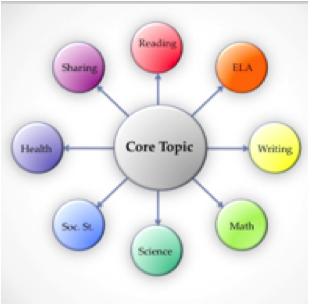Integral Units: Presenting the World to Students as God Created It
Imagine a trip to the grocery store. You think through your meals for the next week and make a grocery list. Obeying traffic laws you travel to the store you’ve chosen. Once you get there, you notice something special is on sale and evaluate if it’s worth getting. You also remember that your flatmate wanted bananas, so you get some even though they aren’t on the list. As you check out, you exchange pleasantries with the cashier.
 Now think about all the different knowledge sets you used: language skills–to write, read, communicate; maths skills to calculate, analyse, and evaluate; a knowledge of science, economics, civics, and nutrition. You also made a dozen ethical decisions in conjunction with these other knowledge sets. The food you choose to eat, where you choose to shop, the laws you follow to get there, how you chose to get there, your consideration of others: practically every step of this trip required you to use both analytical reasoning and moral conscience[1].
Now think about all the different knowledge sets you used: language skills–to write, read, communicate; maths skills to calculate, analyse, and evaluate; a knowledge of science, economics, civics, and nutrition. You also made a dozen ethical decisions in conjunction with these other knowledge sets. The food you choose to eat, where you choose to shop, the laws you follow to get there, how you chose to get there, your consideration of others: practically every step of this trip required you to use both analytical reasoning and moral conscience[1].
In general, most schools separate the instruction of different fields of knowledge. In doing so they also separate the moral underpinning of that subject. However, we live lives that constantly combine all the disciplines fluidly. This is especially true of our faith, which is not something that we occasionally reference, but something that is quintessential to everything we do.
One way to present the world in a more holistic way to students is through integral units. An integral unit focuses on a topic instead of a subject. Just as a traditional unit can combine multiple topics, an integral unit combines multiple subjects.
Integral units are first and foremost about presenting the world to students as God created it: a holistic blending of the different aspects of Creation. Traditional, segmented curriculum compartmentalises knowledge into man-made spheres. This traditional approach to curriculum reinforces a dualist ideology for students, teaching them that God and His realm are separate from the realms of science, history, and writing[2]. The impulse to avoid this pitfall is why so many schools emphasise Biblical integration in all subject areas. However, there are differences between having Biblical integration and using an integral unit or curriculum. Biblical integration seeks to show that Christ is relevant in each sphere of knowledge; Integral curriculum seeks to show students that all of life and learning is inherently full of religious meaning[3].
Integral units are easier to plan and execute than you may think. Start by thinking about a meaningful topic that has practical significance. Kindergarten teachers might choose plants as a topic, while senior history teachers might choose international government policy. Harro Van Brummelen outlines the process of creating an integral unit in detail in his book Steppingstones to Curriculum[4]. In essence, the teacher develops a central theme and key questions about the topic. These questions should focus on ways the topic is actually relevant to the students and the central theme should point to God’s sovereignty over that part of creation.
Topic: Oceans
Theme:
The ocean actively shapes how many people live and is used in many ways, some of which are honouring and some of which are dishonouring to God.
Key Questions:
What is in the ocean? (science & geography)
What do oceans mean to people? (social studies, Bible, arts, writing)
What things affect how the oceans work? (science, maths)
Once these initial steps are completed, teachers should design activities that help students answer the questions (ideally reinforcing the central theme). These activities should involve skills across subject areas. For an ocean-themed unit, students could chart tides, do a dissection, or investigate ocean pollution in maths and science classes. Humanities classes could study how the ocean has been represented and is used. Writing classes should encourage students to research and write about the topic. Discussions of God’s sovereignty and how humans can be good stewards of oceans could take place in both humanities and STEM classes. And, of course, any integral unit on the ocean would be incomplete without enjoying some good seafood!

Integral units are successful when the topic, theme, and questions are truly relevant to students and the activities explore the topic in diverse ways. Teachers can get help from others when planning learning activities outside their own subject. In designing assessments teachers should be particularly careful to consider how they can assess progress in the students’ understanding of the theme and answers to the key questions. Ideally the unit will be different and exciting for the students, the primary teacher, and the other teachers involved in the unit.
For more detailed ideas on how to develop an integrated unit, check out van Brummelin’s work or this resource from ASCD.
David Christians
International Academy, Saint Petersburg
TeachBeyond
[1] Steensma, Geraldine. Shaping School Curriculum, Integral Learning: A Biblical View. Reformed Educational Publishing, 1987. 2-3.
[2] Blomberg, Doug. Wisdom and Curriculum. Dordt College Press, 2007. 26.
[3] Blomberg. 18, 27.
[4] Van Brummelen, Harro. Steppingstones to Curriculum. Purposeful Design Publications, 2002. 167-199.
Photo Credits: Grocery Shopping; amsfrank Flickr via Compfight cc; Seafood, Leonard J Matthews Flickr via Compfight cc.
David Christians has been teaching with TeachBeyond for four years at International Academy in Saint Petersburg, Russia. Having taught everything from AP Calculus to freshman literature to fourth grade, he enjoys teaching art history the most. He’s currently working on a Masters of Education at Covenant College.





